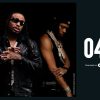-
 play_arrow
play_arrow
Clubalicious Clubalicious Radio
-
 play_arrow
play_arrow
London Calling Podcast Yana Bolder

Dublin, Ireland (July 25, 2024)—Many of the hardest and heaviest prog metal riffs are rooted in the drums, propelled by the exacting performances of the musicians behind the kit. Capturing that precise playing is crucial for the engineer behind the house desk—as FOH pro Chris Edrich knows well. Having manned the consoles for Devin Townsend, Leprous, TesseracT, The Ocean, Alcest, Klone and others, Edrich shared some of his approaches to capturing the kit.
An Audix adherent, Edrich opts to use the mic manufacturer’s D6 on kick drum, i5 on snare top with D2 on snare bottom, D4 on toms, SCX1 on hi-hat, SCX25A studio condensers as overheads, and even an ADX60 boundary mic in an unexpected place.
“With most of the bands I work with, drums and vocals are almost the only stage sound,” explains Edrich. “Guitarists, for example, are usually playing through modeling amps such as the Kemper or AxeFX, going straight into the console. There’s not a lot to bleed into the drum mics, but it also makes getting a great drum sound that much more important.”
Noah Kahan: Singer, Songwriter, Stadium Filler
Capturing the kick drum, Edrich opts for using the D6 outside, but inside, he places an ADX60 boundary microphone, he says: “It’s very tiny and easy to place, and gives me a nice, bright attack because it’s a condenser. It’s a great complement to the D6, which gives me the big body of the kick.”
Edrich uses multiple D2s around the kit, in traditional and non-traditional spots. “On the bottom of the snare, I use the D2, which people think of as a tom mic but is in fact great in this application,” he explains, adding, “It has a lot of air but not too much aggressiveness in the high-mids.”
For the various cymbals, Edrich tends to go with the SCX1, a compact small-diaphragm condenser, and on overheads, he turns to a pair of SCX25A condenser mics. “Everything over 10 kHz is crisp without being harsh; it’s a very produced sound I have to do almost no work to get,” he says. “As far as rejection goes onstage, they’re as good as a condenser can be. I can even compress the SCX25A a little bit, getting virtually no bleed from outside the drums. I realize they’re very well known as piano mics and sometimes used in audiophile reference tests, but they’re my favorite drum overheads ever. I think people should be more aware of them for that.”
Written by: Admin
Similar posts
Recent Comments
No comments to show.Featured post

Latest posts
Current show
Upcoming shows

Love To Be
The Global Connection
09:00 - 11:00
Fresh Is Fresh
This Weeks Hottest Releases
11:00 - 15:00
House Story
Dance Anthems
15:00 - 17:00
STARDUST
Presented by Bergwall
17:00 - 19:00
Femme House
Lp giobbi
19:00 - 20:00Chart
Powered by Dee jay promotions visit us













 Invalid license, for more info click here
Invalid license, for more info click here